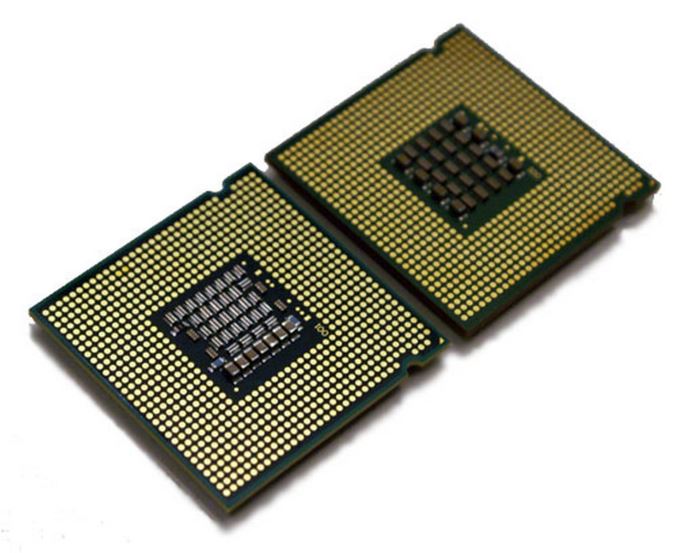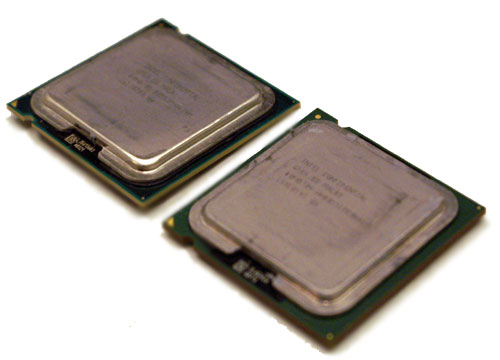Ten Year Anniversary of Core 2 Duo and Conroe: Moore’s Law is Dead, Long Live Moore’s Law
by Ian Cutress on July 27, 2016 10:30 AM EST- Posted in
- CPUs
- Intel
- Core 2 Duo
- Conroe
- ITRS
- Nostalgia
- Time To Upgrade

Today marks a full 10 years since the first Core 2 Duo processors, and hence Intel’s 64-bit Core microarchitecture, were made officially available at retail. These included a number of popular dual-core processor parts, including the seemingly ubiquitous E6400 and the Core 2 Extreme X6800. These were built on Intel’s 65nm process, and marked a turning point in the desktop processor ecosystem. To quote Anand in our launch review: ‘you’re looking at the most impressive piece of silicon the world has ever seen’.
Ten Year Anniversary of Core 2 Duo and Conroe
As part of this piece we will also look at some of the predictions for the future, from the latest (and possibly last) International Technology Roadmap for Semiconductors report, which predicts the stalling of smaller silicon manufacturing nodes over the next 10-15 years.
The first part of this article borrows heavily from Johan’s original look into the Intel Core microarchitecture back in 2006. It’s an awesome read.
Back When I Were A Lad
For a number of our readers, the launch of Conroe was a vast change in the processing landscape. The family of Netburst, Northwood and Prescott processors, in the form of Pentium D and Pentium 4, showed that pursuing the frequency race pushed the silicon far outside its efficiency zone and left a hot, power hungry mess in its wake. It didn’t even come with a muscular V8 sound, and AMD’s Athlon 64 X2 line had taken both the performance and efficiency crown.

Core 2 Duo (left) vs Pentium D (right)
From the perspective of Intel, it had to incorporate a significant paradigm shift in the way it approached the core microarchitecture – no more long pipelines to bump up clock rates to start. The Core microarchitecture design was marketed as a blend of Pentium Pro and Pentium M techniques, as well as the Netburst architecture, however as Johan pointed out at the time, it is significantly Pentium M and it is very hard to find anything Netburst in there. It wasn’t as simple as ‘adding a few functional units or decoders on Yonah and calling it a day’, almost 80% of the architecture and circuit design had to be redone.
As part of this piece, we’re going to take another look at the original architecture improvements of the Core microarchitecture design and some of our old performance metrics from a decade ago.
27th July 2006: Core 2 Launch Day
Ten years ago, Intel launched the following five processors:
| CPU | Clock Speed | L2 Cache |
| Intel Core 2 Extreme X6800 | 2.93GHz | 4MB |
| Intel Core 2 Duo E6700 | 2.66GHz | 4MB |
| Intel Core 2 Duo E6600 | 2.40GHz | 4MB |
| Intel Core 2 Duo E6400 | 2.13GHz | 2MB |
| Intel Core 2 Duo E6300 | 1.86GHz | 2MB |
The X6800 sits at the top with a higher clock speed with a higher supported FSB-to-core ration than previous Intel processors. The Core 2 processors all came from a 143mm2 die, compared the 162mm2 of Pentium D, and they both seem tiny by comparison to the large die sizes we see 2016 for things like the P100. These were chips without integrated graphics either. The introduction of Core 2 pushed the prices of the Pentium D processors down, to give this interesting table:
| CPU | Clock Speed | L2 Cache | Price |
| Intel Core 2 Extreme X6800 | 2.93GHz | 4MB | $999 |
| Intel Core 2 Duo E6700 | 2.66GHz | 4MB | $530 |
| Intel Core 2 Duo E6600 | 2.40GHz | 4MB | $316 |
| Intel Core 2 Duo E6400 | 2.13GHz | 2MB | $224 |
| Intel Core 2 Duo E6300 | 1.86GHz | 2MB | $183 |
| Intel Pentium D 945 | 3.40GHz | 2MBx2 | $163 |
| Intel Pentium D 915 | 2.80GHz | 2MBx2 | $133 |
| Intel Pentium D 820 | 2.80GHz | 1MBx2 | $113 |
| Intel Pentium D 805 | 2.66GHz | 1MBx2 | $93 |
Comparing this to recent Intel processors, and the X8600 matches the list price of the Core i7-5960X (an 8-core part), whereas the popular Core 2 Duo E6400 at $224 at the same price as the Core i5-6600.
A few years ago, I salvaged a super old computer of mine with an E6400 and took it for a spin for a pipeline piece entitled ‘Dragging Core 2 Duo into 2013’. We know that a number of users today are still using the old platform as their day to day machine, and given that it is now celebrating its 10th birthday, it is interesting that anyone wanting to play around with the old hardware can get a motherboard, memory and CPU from eBay for $50-70.
My crusty C2D Setup from 2013











158 Comments
View All Comments
patel21 - Thursday, July 28, 2016 - link
Me Q6600 ;-)nathanddrews - Thursday, July 28, 2016 - link
Me too! Great chip!Notmyusualid - Thursday, July 28, 2016 - link
Had my G0 stepping just as soon as it dropped.Coming from a high freq Netburst, I was thrown back, by the difference.
Since then I've bought Xtreme version processors... Until now, its been money well spent.
KLC - Thursday, July 28, 2016 - link
Me too.rarson - Thursday, August 4, 2016 - link
I built my current PC back in 2007 using a Pentium Dual Core E2160 (the $65 bang for the buck king), which easily overclocked to 3 GHz, in an Abit IP35 Pro. Several years ago I replaced the Pentium with a C2D E8600. I'm still using it today. (I had the Q9550 in there for a while, but the Abit board was extremely finnicky with it and I found that the E8600 was a much better overclocker.)paffinity - Wednesday, July 27, 2016 - link
Merom architecture was good architecture.CajunArson - Wednesday, July 27, 2016 - link
To quote Gross Pointe Blank: Ten years man!! TEN YEARS!guidryp - Wednesday, July 27, 2016 - link
Too bad you didn't test something with a bit more clock speed.So you have ~2GHz vs ~4GHz and it's half as fast on single threaded...
Ranger1065 - Wednesday, July 27, 2016 - link
I owned the E6600 and my Q6600 system from around 2008 is still running. Thanks for an interesting and nostalgic read :)Beany2013 - Wednesday, July 27, 2016 - link
Built a Q6600 rig for a mate just as they were going EOL and were getting cheap. It's still trucking, although I suspect the memory bus is getting flaky. Time for a rebuild, methinks.And a monster NAS to store the likely hundreds of thousands of photos she's processed on it and which are stuck around on multiple USB HDDs in her basement.
It's not just CPUs that have moved on - who'd have thought ten years ago that a *good* four bay NAS that can do virtualisation would be a thing you could get for under £350/$500 (QNAP TS451) without disks? Hell, you could barely build even a budget desktop machine (just the tower, no monitor etc) for that back then.
God I feel old.